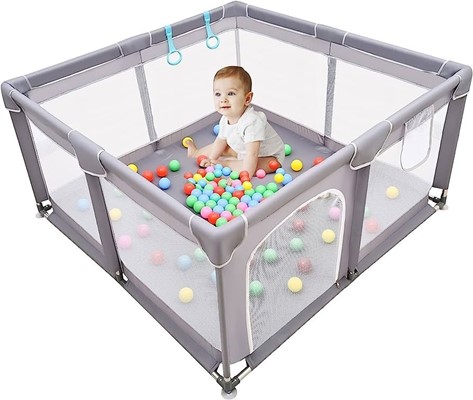The practical nurse (PN) is told that she keeps her 2-year-old child in a playpen so he will not get dirty. Which statement should the PN use in responding to this concern about using a playpen?
Overconcern about appearance can be harmful.
Playpens provide a sense of security for the child
Playpens provide a safe environment for a toddler.
Children need time to actively explore their environment.
The Correct Answer is D
- A playpen is a portable enclosure that provides a confined space for a child to play in. It can be useful for keeping a child safe and supervised when the caregiver is busy or needs a break, but it should not be used as a substitute for active play or interaction with the caregiver or others.
- A 2-year-old child is in the developmental stage of toddlerhood, which is characterized by rapid physical, cognitive, social, and emotional growth. Toddlers are curious and eager to learn about the world around them, and they need opportunities to explore, experiment, and manipulate objects and materials. They also need stimulation, guidance, and feedback from their caregivers and peers to develop their language, problem-solving, and social skills.
- Keeping a 2-year-old child in a playpen for long periods of time or to prevent them from getting dirty can have negative effects on their development and well-being. It can limit their physical activity, creativity, and independence, and it can cause boredom, frustration, or resentment . It can also interfere with their atachment and bonding with their caregiver, as well as their self-esteem and self-image.
- Therefore, the practical nurse (PN) should use the statement "Children need time to actively explore their environment" in responding to this concern about using a playpen. This statement reflects the developmental needs and rights of the child, and it encourages the caregiver to provide a more stimulating and supportive environment for the child. It also implies that getting dirty is not a problem, but rather a natural and healthy part of play and learning.
- Therefore, option D is the correct answer, while options A, B, and C are incorrect. Option A is incorrect because it is judgmental and may offend or discourage the caregiver.
Option B is incorrect because it is not true that playpens provide a sense of security for the child, as they may feel isolated or restricted in them.
Option C is incorrect because it is not true that playpens provide a safe environment for a toddler, as they may pose hazards such as entrapment, suffocation, or injury from falling or climbing out of them.

Nursing Test Bank
Naxlex Comprehensive Predictor Exams
Related Questions
Correct Answer is {"A":{"answers":"C"},"B":{"answers":"A"},"C":{"answers":"C"},"D":{"answers":"A"},"E":{"answers":"A"}}
No explanation
Correct Answer is D
Explanation
A. Instructing the client about the importance of regular medical appointments is important but not the priority because it is a secondary prevention strategy that aims to detect and treat any complications or changes in the client's condition early. The client should have regular follow-up visits with an endocrinologist, a diabetes educator, an ophthalmologist, a podiatrist, a dentist, and other health care providers as needed.
B. Encouraging the client to participate in daily exercise is important but not the priority because it is a tertiary prevention strategy that aims to reduce disability and improve quality of life for clients with chronic conditions. Exercise can help lower blood glucose levels, improve insulin sensitivity, reduce cardiovascular risk factors, enhance mood, and promote weight management for clients with type 1 diabetes mellitus. The client should consult with their health care provider before starting an exercise program and follow safety guidelines such as checking blood glucose levels before and after exercise, wearing appropriate footwear and clothing, carrying a source of fast-acting carbohydrate, and staying hydrated.
C. Explaining proper foot care techniques to the client is important but not the priority because it is a tertiary prevention strategy that aims to prevent or minimize complications such as foot ulcers, infections, and amputations for clients with type 1 diabetes mellitus. Foot care includes inspecting feet daily for any injuries or abnormalities, washing feet with mild soap and warm water, drying feet thoroughly especially between toes, applying moisturizer to prevent dryness and cracking, trimming toenails straight across and filing edges smooth, wearing clean cotton socks and well-fitting shoes, avoiding walking barefoot or exposing feet to extreme temperatures or pressure, and seeking medical attention for any foot problems.
D. Ensuring that the client understands the medication regimen is the nurse's priority because type 1 diabetes mellitus requires lifelong insulin therapy to maintain blood glucose levels within normal range and prevent complications such as ketoacidosis, hypoglycemia, and organ damage. The client needs to know how to administer insulin injections, monitor blood glucose levels, adjust insulin doses according to carbohydrate intake and physical activity, recognize and treat signs and symptoms of hypo- and hyperglycemia, and store insulin properly.
Whether you are a student looking to ace your exams or a practicing nurse seeking to enhance your expertise , our nursing education contents will empower you with the confidence and competence to make a difference in the lives of patients and become a respected leader in the healthcare field.
Visit Naxlex, invest in your future and unlock endless possibilities with our unparalleled nursing education contents today
Report Wrong Answer on the Current Question
Do you disagree with the answer? If yes, what is your expected answer? Explain.
Kindly be descriptive with the issue you are facing.
